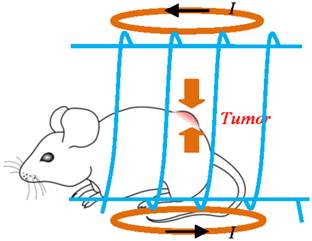Cancer remains one of the biggest health problems worldwide, which is why scientists devote a lot of resources to developing new therapies. Various cunning new strategies are being explored, such as proteins that make cancer cells self-destruct or using a marker that makes a tumour light up, rendering us able to find tiny clumps of bad cells during surgery. A recently published attempt uses magnetic fields together with nanoparticles to create heat, effectively destroying cancerous cells.
Targeting
In their experiments, the scientists delivered a load of small iron oxide particles, measuring just 15nm (0.000015mm) in width, to human tumours engrafted in mice. Specifically, experiments consisted of tumours derived from the head and neck, to which the nanoparticles were targeted by injection. By making sure only the bad cells receive the treatment, it is possible to reduce side effects. Current treatments, such as radiotherapy or chemotherapy are much less specific.
Magnetism
A magnetic field was created that changes its direction a 100.000 times per second. By doing this, magnetic particles situated inside the tumour start to vibrate and heat up. The magnetic waves caused a local temperature of 40 degrees celcius at the injection site, up from an average of 28 degrees celcius body temperature right after the experiment started. It took the magnetic nanoparticles just a few minutes to make the tumour site reach that temperature.
Results
Right after heating up, the scientists observed tumour cells starting to die. While that is good news, the bad part is that the killing was not very 'clean'. Cancer cells were effectively destroyed, instead of undergoing a process known as apoptosis. By inducing apoptosis, cells die by wrapping up all cellular components into small spheres, which can be recycled by surrounding cells. Necrosis, the destruction of cells, is a messy business and leaves debris lying around which can be harmful and cause inflammation. Some cellular debris is better than having a tumour growing inside of you, of course.
Outlook
Because magnetically heated nanoparticles can reach their tumour-killing temperature in mere minutes, treatment is exceptionally fast. It is still necessary to prove that this method works in humans, and show it effectively kills all the tumour cells without harming its surroundings. An additional challenge is targeting: the scientists in the present study targeted malicious cells by injecting the nanoparticles directly into the tumour. However, not all cancers are reachable by injection, which is why an effective therapy should have additional means of targeting. This can be achieved by attaching an antibody to the nanoparticle that binds specifically to tumour cells. While this novel therapy sounds interesting and promising, optimization is required to get this into the clinic.
Targeting
In their experiments, the scientists delivered a load of small iron oxide particles, measuring just 15nm (0.000015mm) in width, to human tumours engrafted in mice. Specifically, experiments consisted of tumours derived from the head and neck, to which the nanoparticles were targeted by injection. By making sure only the bad cells receive the treatment, it is possible to reduce side effects. Current treatments, such as radiotherapy or chemotherapy are much less specific.
Magnetism
A magnetic field was created that changes its direction a 100.000 times per second. By doing this, magnetic particles situated inside the tumour start to vibrate and heat up. The magnetic waves caused a local temperature of 40 degrees celcius at the injection site, up from an average of 28 degrees celcius body temperature right after the experiment started. It took the magnetic nanoparticles just a few minutes to make the tumour site reach that temperature.
Results
Right after heating up, the scientists observed tumour cells starting to die. While that is good news, the bad part is that the killing was not very 'clean'. Cancer cells were effectively destroyed, instead of undergoing a process known as apoptosis. By inducing apoptosis, cells die by wrapping up all cellular components into small spheres, which can be recycled by surrounding cells. Necrosis, the destruction of cells, is a messy business and leaves debris lying around which can be harmful and cause inflammation. Some cellular debris is better than having a tumour growing inside of you, of course.
Outlook
Because magnetically heated nanoparticles can reach their tumour-killing temperature in mere minutes, treatment is exceptionally fast. It is still necessary to prove that this method works in humans, and show it effectively kills all the tumour cells without harming its surroundings. An additional challenge is targeting: the scientists in the present study targeted malicious cells by injecting the nanoparticles directly into the tumour. However, not all cancers are reachable by injection, which is why an effective therapy should have additional means of targeting. This can be achieved by attaching an antibody to the nanoparticle that binds specifically to tumour cells. While this novel therapy sounds interesting and promising, optimization is required to get this into the clinic.


No comments:
Post a Comment